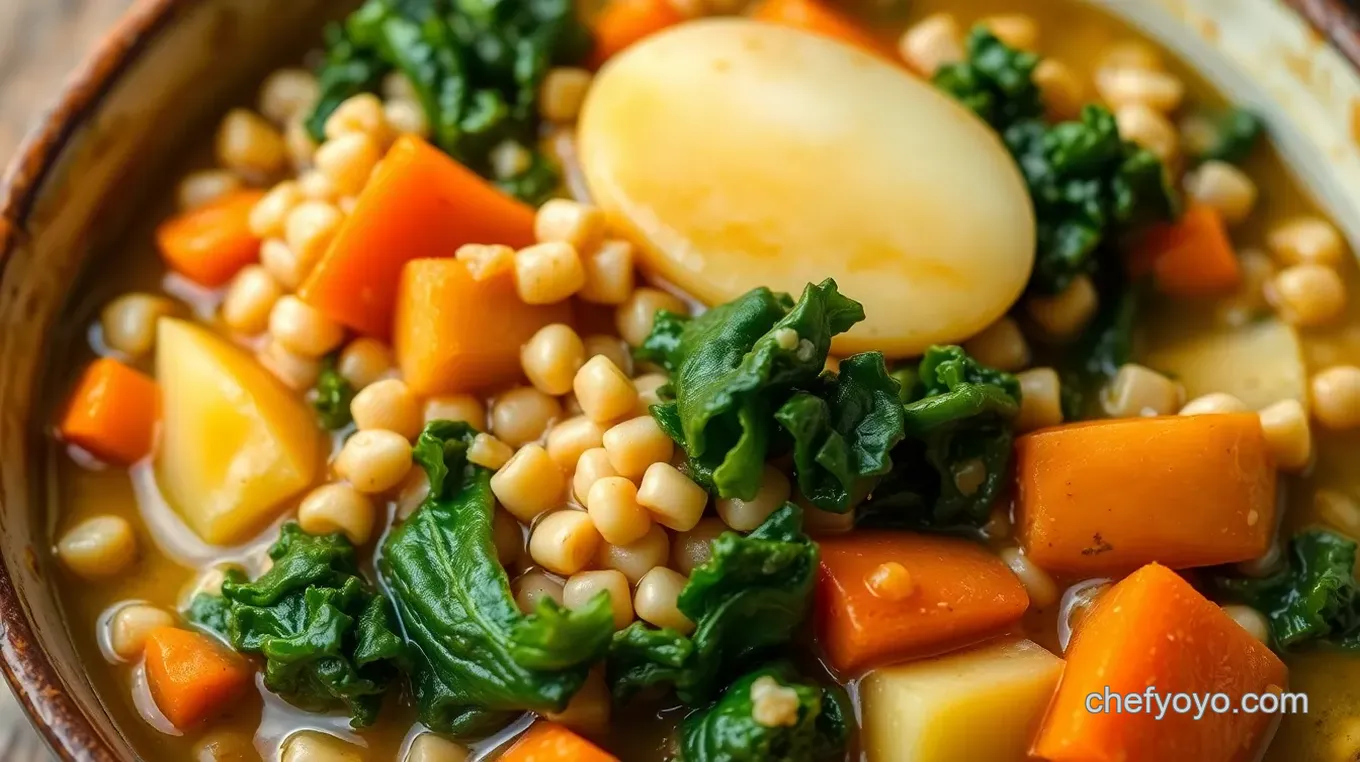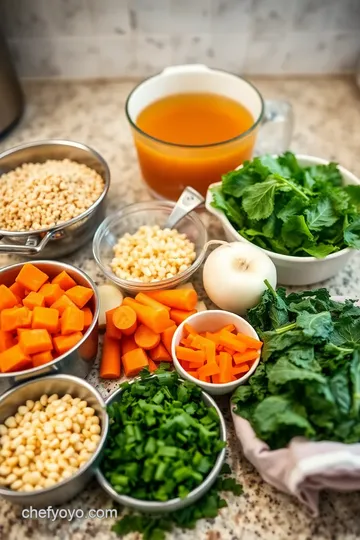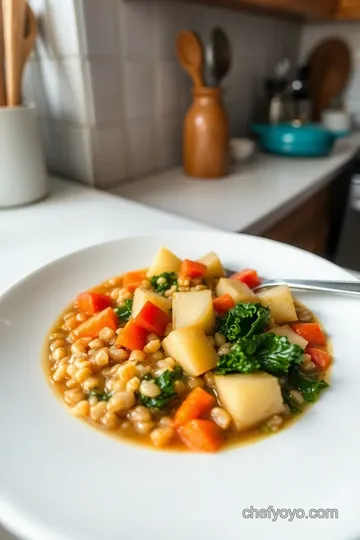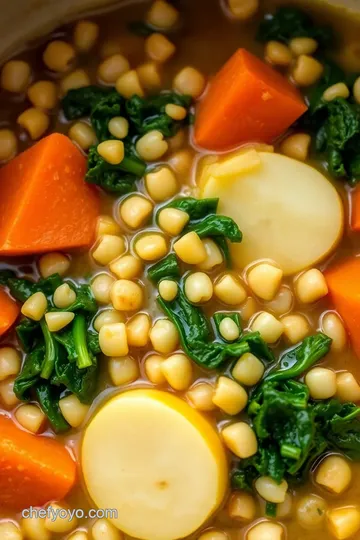Medieval Pottage with Barley and Root Vegetables
Looking for a cozy meal? Dive into the primary source of middle ages food recipes with these 7 hearty pottage variations! Discover culinary history now!

- What’s Your Idea of Comfort Food?
- Unearthing the History of Pottage
- The Complete Guide to Authentic Medieval Pottage
- Your New Favorite Medieval Pottage
- Health and Nutrition Highlights
- Recipe at a Glance
- Quality Ingredients Breakdown
- Kitchen Equipment Essentials
- Professional Cooking Guide
- Success Guaranteed Tips
- Perfect Presentation
- Storage and Make-Ahead
- Creative Variations
- Complete Nutrition Guide
- Expert FAQ Solutions
- Recipe Card
What’s Your Idea of Comfort Food?
Have you ever thought about what truly makes your heart feel warm and snuggly on a chilly evening? for many, the answer lies in a steaming bowl of something cozy — like medieval pottage with barley and root vegetables .
This recipe takes you back in time, bridging culinary history and present-day comfort with just a bit of simmering magic.
In just about an hour, you can create this delightful dish that’s not only easy to whip up but, i promise you, will have the family crowding around the table.
No fancy tricks here; the hardest part is waiting for it to cook!
Unearthing the History of Pottage
Pottage, a staple of middle ages cuisine , has roots that dig deep into our past, displaying a rich culinary heritage .
Imagine peasants in their humble cottages on a rainy day, stirring a pot filled with a blend of seasonal vegetables and grains.
Pottage was practical, nutritious, and versatile, serving as a primary source of sustenance for many during medieval times. it thrived on what was available, often drawing from the garden or local market.
This kind of cooking remodels the concept of ‘farm-to-table’ before it was even a thing.
So, what makes this particular pottage so special? first off, it’s a hearty soup filled with the earthy goodness of root vegetables and wholesome barley, making it a delightful addition to any comfort food roster.
Plus, it's adaptable — toss in whatever vegetables you have lying around! you’ll find that it’s not just nourishing for the body but a warm hug for the soul — the kind of dish that makes your home smell like love.
The Complete Guide to Authentic Medieval Pottage
Pottage is woven into the very fabric of cooking throughout history; it’s not just a meal but a reflection of culture and survival.
Historically, it was the kind of dish that could stretch ingredients, catering to entire families. before refrigeration and fancy imports, you relied on what was at hand, making this dish both rustic and deeply personal.
Its fascinating origin story ties back to the humble kitchens and firesides of britain where folks learned to cook with what was seasonal, a testament to traditional meals that speak to the heart of old world recipes .
Today, with the revival of interest in historical recipes , many chefs are drawing upon these rich, comforting dishes. the combination of flavors in this pottage doesn’t just provide sustenance; it brings people together.
It’s like taking a comforting step back into history while still enjoying the taste of modern-day realizations.
Your New Favorite Medieval Pottage
Spoiler alert: you’re about to fall in love with the unique flavor combinations found in this pottage. the barley adds a rustic, nutty flavor while root vegetables, like carrots and parsnips, contribute natural sweetness.
And let’s not forget kale, bringing a bit of that vibrant green we all need. the techniques are simple enough that even novice cooks can wield the spoon effectively; just remember to mind the simmering, and you’re golden!
From personal experience, i once got a bit carried away with spices and ended up with something… well, let’s say it wasn’t my finest hour.
But now? after trial and error, i’ve perfected it. each time i put this recipe together, i get a little more excited, knowing i’m playing with flavors that turned heads and filled bellies centuries ago.
If you mess up, don’t sweat it! just learn and adjust next time.
Health and Nutrition Highlights
Aside from being downright delicious, this pottage has its health perks too! barley is a healthy grain loaded with nutrients — think fiber, vitamins, and iron.
It's especially handy to have during those autumn months when you want cozy recipes that still have a nutrition boost.
Plus, it's vegetarian! just stay mindful if you need to keep it gluten-free and switch out the barley for wholesome quinoa or something similar.
When cooking heartily, you're not just filling bellies but nurturing bodies with essential nutrients and warmth. It’s the kind of balanced nutrition that makes you feel good inside and out!
Recipe at a Glance
- Total Preparation Time : 15 minutes
- Cooking Time : 1 hour
- Skill Level Required : Medium
- Serving Size : 4 servings
- Cost Efficiency : Super budget-friendly!
So, are you ready to dive into the ingredients and craft this medieval delight? gather your pots and veggies, and let’s make something comforting! the next section will break down exactly what you need to start creating your warm bowl of history in the making.

Quality Ingredients Breakdown
Premium Core Ingredients
When it comes to making your medieval pottage, the quality of your ingredients really matters. Here’s what you’ll need:
-
1 cup barley, rinsed : this humble grain is a primary source of middle ages food recipes , giving your pottage that hearty, rustic feel.
Look for pearl barley, as it cooks faster. for optimum flavor, choose fresh, whole grains—you’ll know they’re good if they have a nutty aroma when you open the package! store in a cool, dry place.
-
4 cups vegetable broth or water : homemade vegetable broth makes a huge difference but if you're short on time, good-quality store-bought is fine.
Just pay attention to sodium levels. i once grabbed a low-quality brand and, yikes , the saltiness nearly made me pass out! when not in use, store in the fridge or the freezer for longer-term storage.
-
Root vegetables : we’re talking about two medium carrots, two medium parsnips, and one medium onion. check for vibrant colors and firm texture—this usually indicates freshness.
And hey, if they’re a bit funky-looking, don’t judge! a little dirt won’t hurt. peel and dice, and they’ll find their place in your pot.
-
2 cloves garlic, minced : fresh garlic packs a delightful punch. go for bulbs that feel heavy and firm with little to no sprouting.
Store them in a mesh bag or basket for good ventilation.
-
1 cup kale or other leafy greens, chopped : i’m a big fan of kale for this dish, but if you can find fresh spinach or chard, that works too! go for bright, colorful leaves, avoiding yellow or wilted ones.
Keep leafy greens in a damp kitchen towel in the fridge to extend their freshness.
-
2 tablespoons olive oil : cheap olive oil simply won't cut it here! a rich, extra virgin olive oil ups the flavor nicely.
If it smells fruity or peppery, you’ve got a good one. store it in a cool, dark place to preserve its quality.
-
Season to taste : you’ll need one teaspoon salt (but don’t be too hasty), half a teaspoon black pepper, one teaspoon dried thyme, and one teaspoon dried parsley.
High-quality spices can elevate your dish significantly. look for whole spices or organic varieties for better flavor, and be sure to store them in airtight containers away from heat, light, and moisture.
-
Optional saffron (¼ teaspoon) : now, if you’re feeling posh, this spice will add a luxurious touch to your potage.
Look for deep red threads and avoid any overly processed stuff. it’s pricey but, oh boy, it makes a difference! keep it stored in a cool, dark place and have fun with it!
Signature Seasoning Blend
You may know that medieval dishes require herbal seasoning ! Building on the core ingredients listed above, these seasonings are crucial:
-
Spice combinations : Dried herbs like thyme and parsley work wonders here. Feel free to toss in some rosemary for an aromatic charm reminiscent of old-world flavors.
-
Flavor enhancers : A dash of freshly cracked black pepper adds warmth, while a splash of lemon juice—if you have some handy—can make everything pop.
-
Aromatic additions : Cinnamon and nutmeg are unexpected, but they can invoke the medieval culinary spirit. Just a pinch transforms the dish beautifully!
Smart Substitutions
Life can be unpredictable (as I painfully learned when I forgot to pick up broth). Here are some smart swaps to keep your pottage delicious:
-
Alternative ingredients : Don’t have barley? Quinoa is an excellent substitute that cooks faster. Just reduce your liquids slightly.
-
Dietary swaps : For a gluten-free option, use rice or millet instead of barley.
-
Emergency replacements : If you find yourself out of kale, any leafy green will suffice—arugula, Swiss chard, or even frozen spinach can do the trick in a pinch.
-
Seasonal variations : Change it up! As winter gives way to spring, consider adding tender young greens or peas when they're fresh and plentiful.
Kitchen Equipment Essentials
Now that we’ve got our ingredients lined up, let’s chat about the must-have tools to make this medieval dish a reality:
-
Must-have tools : You’ll need a good-sized pot for simmering; a Dutch oven is fabulous if you have it. A wooden spoon is perfect for stirring without issuing scratches.
-
Recommended appliances : A cutting board and a knife are essential, obviously. Investing in a chef’s knife can make chopping veggies much more enjoyable!
-
Helpful gadgets : If you have a fine-mesh sieve, it’s fantastic for rinsing grains and draining anything—but no sweat if you don’t. Just use a colander.
-
Home alternatives : Can’t find kale? A quick raid of your garden (or your fridge) for any leafy greens will work.
Pro Ingredient Tips
-
Selection secrets : Always buy produce that’s in season, often leading to better flavors and lower prices. Farmers’ markets are a great quality source.
-
Quality markers : Fresh herbs should feel perky, not dried out—not that I ever grabbed the wilted stuff in desperation or anything!
-
Storage solutions : Keep grains in airtight containers to protect from pests and humidity.
-
Money-saving tips : Buy spices in bulk. They’ll last longer than you think, and you won’t be shelling out for little jars that don’t last.
Alright friends, with all these fabulous ingredients, we're ready to jump into the instructions section . Stay tuned; it’s where the magic of medieval cooking happens!
Professional Cooking Guide
Essential Preparation Steps
Let’s kick off this cozy journey with some essential mise en place . this fancy term simply means "everything in its place," but it's the secret sauce of professional cooking.
Start by gathering your ingredients and tools: chopping boards, a large pot, measuring spoons, and a stirring spoon. oh, and don't forget the cozy apron.
Trust me, it helps!
As for prep techniques, get those veggies diced. you want uniform pieces, so they all cook at the same rate.
For our medieval pottage, you’ll dice your carrots, parsnips, and onion into bite-sized pieces. this technique not only looks great but ensures even cooking and a pleasing texture.
Now, let’s chat about time management. since the pottage takes a while to simmer away happily, use this prep time wisely.
While the barley rinses, get your veggies going. this multitasking makes everything flow seamlessly.
And organization tips? keep a trash bowl handy for those veggie scraps. it’s a small step, but it makes cleanup a breeze.
Plus, it keeps your workspace tidy, so you can focus on the good stuff—like the lovely smell wafting from your pot.
Professional Cooking Method
Now, onto the fun part, the cooking method! first, prepare the barley by giving it a good rinse under cold water.
I once skipped this step, and boy, did it lead to a gummy mess! rinsing is key to a smooth potage.
Heat your olive oil in a large pot over medium heat. toss in your onion, sautéing it until it turns soft and fragrant, about 3-4 minutes.
The garlic follows suit, and oh, the aroma will have your family wondering what you’re brewing up!
Mix in the diced carrots and parsnips, allowing them to soften for another 5-7 minutes. Here’s a pro tip I learned: stirring occasionally helps develop those beautiful flavors.
Now, it's time to combine everything. add the rinsed barley right into the pot along with the broth and spices.
If you've decided to splurge a bit (and why not?), toss in some saffron for that royal touch. it’s like giving your pottage a golden crown!
Bring it all to a boil, then reduce the heat. cover and let it simmer for about 45 minutes. here’s where patience is key! you'll know it’s ready when the barley is tender but still has a little bite to it.
Just before you’re ready to serve, add those vibrant greens—kale or whatever leafy stuff you’ve got on hand. cook it for just five minutes, and voilà! your pottage is bubbling and asking to be enjoyed.
Expert Techniques
Let’s dive deeper into those expert techniques! for texture control, you might want to experiment a little. if you desire a thicker potage, simply reduce the liquid or extend the simmering time.
Remember, it’s all about what feels right for you.
When it comes to seasoning, don’t hold back! If herbs are your jam, use fresh ones for a flavor boost. Toss them in at the last moment to preserve that lovely freshness.
One of the critical steps i’ve learned is to taste as you go. hate to admit it, but i’ve overlooked this and ended up with under-seasoned dishes before! so, if something feels off, adjust your spices until it sings.
And a quality check? when you spoon the potage, it should be thick and creamy with vibrant veggie colors peeking through.
If it’s looking too thin, simmer it uncovered for a while longer.
Success Strategies
Every great cook has encountered pitfalls, and I’m no exception. If you find your pottage is a little too thick, stir in a splash of broth or water to loosen it up.
Quality assurance comes down to using fresh ingredients. seasonal vegetables not only taste better, but they’re also packed with nutrients—think of it as a little healthy nostalgia from old-world recipes.
It’s heartwarming how the roots of our cooking bring the past into our kitchens.
Now, let’s talk about perfect results. check the barley for doneness; it should have a chewy texture, not mushy. the kale needs to look bright and inviting, not wilted into oblivion.
Remember, presentation counts a lot!
As we savor this hearty medieval pottage with barley and those rustic roots, i can’t help but reflect on how food connects us to our history.
My journey in exploring primary source of middle ages food recipes has been enlightening, and i can’t wait to share more of this culinary adventure with you.
Stick around for more tales from the kitchen and tips on how to whip up other comforting dishes that might just become your next family favorite!

Success Guaranteed Tips
When you think about success in the kitchen, especially while trying out traditional dishes like our Medieval Pottage, there are a few pro tips you really shouldn't ignore.
Professional Insights
First, always stick to the basics of cooking techniques. just like medieval cooks who largely relied on slow cooking methods, you’ll want to allow your ingredients the time they deserve to mingle and develop deep flavors.
Remember, low and slow is the key to success!
Expert Techniques
Consider learning a few historical culinary techniques . for example, simmering your ingredients rather than boiling them fiercely will preserve the integrity of the vegetables while extracting their natural flavors.
The goal here is to create a cozy, heartfelt dish that warms the soul.
Kitchen Wisdom
One nugget of kitchen wisdom i've picked up over the years is to keep tasting as you go. even if you feel you're following the primary source of middle ages food recipes to the letter, every kitchen (and every cook!) has their unique quirks.
Don’t hesitate to adjust seasonings to suit your taste!
Success Guarantees
By cooking with love and care, you almost guarantee a hit with your medieval pottage. Trust me, friends, nothing beats the satisfaction of sharing a delicious, soul-satisfying meal that also comes with a slice of history!
Perfect Presentation
Once your pottage is bubbling away and filling your home with an inviting aroma, don't forget to think about how you present it.
Plating Techniques
Think cozy and rustic. a large wooden bowl or even a simple, handcrafted ceramic dish can enhance the presentation. ladle the pottage generously, letting it swirl and brim over the edges for that hearty, inviting look.
Garnish Ideas
A drizzle of good-quality olive oil right before serving can add a glistening finish. Toss in a sprinkle of fresh herbs, or even edible flowers if you’re feeling fancy—that’s how you can transform your hearty potage into a feast for the eyes and the belly!
Serving Suggestions
Serve it warm with some crusty bread on the side, letting everyone grab a chunk to dunk into that warm goodness.
If you're feeling adventurous, a side of pickled vegetables can really amp up the flavors too!
Visual Appeal Tips
Play with colors! the vibrant orange of carrots, the earthy tones of parsnips, and the deep green of kale come together in a stunning visual presentation.
Your guests won’t be able to resist!
Storage and Make-Ahead
Let’s be honest: life gets busy! So here’s how you can keep your pottage fresh.
Storage Guidelines
Once it's cooled, store your pottage in an airtight container . It can last for up to three days in the fridge.
Preservation Methods
If you’re looking to store it longer, consider freezing it. Just pour it into freezer-safe containers, leaving a little space for expansion. You’ll have meals ready to go on those hectic evenings!
Reheating Instructions
When you’re ready to dig in, just heat it up on the stove over low heat. Add a splash of water or broth as needed to help regain that silky texture.
Freshness Tips
Here’s a tip i learned the hard way: never reheat it too quickly! stirring occasionally as you go can keep everything from separating.
Trust me, it saves you from some not-so-tasty bowls of soup.
Creative Variations
Don’t be afraid to make this dish your own with some creative spins.
Flavor Adaptations
Love spices? Try adding a pinch of cumin or even a hint of cinnamon for an unexpected twist—trust me, it’s surprisingly delightful!
Dietary Modifications
For a hearty vegetarian dish , stick to the pottage as is, or throw in some beans for added protein.
If you want to make it 100% vegan, simply omit any cheese garnishes, if you choose to use them.
Seasonal Twists
Embrace the seasons! In the fall, add pumpkin or squash for sweetness. Come spring, fresh peas or asparagus lend a delicate touch of green.
Regional Variations
Feel like exploring? Try swapping out the barley for farro or quinoa for a different texture or flavor entirely.
Complete Nutrition Guide
Cooking is not just about flavor; it’s also about nutrition!
Detailed Breakdown
A serving of this pottage is not only comforting but packed with nutritional value . You’ve got wholesome grains, root vegetables, and leafy greens, all contributing to a balanced meal.
Health Benefits
Barley is a fantastic source of fiber and minerals, helping you feel full while supporting digestion. Plus, kale is a powerhouse of vitamins!
Dietary Information
Being high in fiber, this dish can easily fit into a healthy grains diet, making it a great option for anyone looking to enjoy a nourishing meal.
Portion Guidance
Each serving size is generous but don’t be shy to have a second helping. After all, who could resist that hug-in-a-bowl feeling?
Expert FAQ Solutions
Let’s tackle some common kitchen concerns!
Common Concerns
“Will I get it right?” Yes! Cooking is as much about experimenting as it is about following a recipe. Don’t sweat the small stuff!
Expert Answers
“Can I substitute broth?” Absolutely! Water works great, especially if you have herbs to add in.
Troubleshooting Guide
If you find your pottage is too thick, just add a bit of broth or water during the last few minutes of cooking to bring everything back together.
Success Tips
Remember, even medieval cooks faced many challenges. Embrace the process, learn from mistakes, and make a delicious meal that brings a smile!
So there you have it! whether you're spinning some historical recipes for fun or just trying to find that perfect cozy meal , this medieval pottage has got your back.
It’s a simple yet delicious way to honor the culinary history of the middle ages while enjoying a warm bowl of comfort.
🥣
Happy cooking, my friends! Enjoy your journey through the past right in your kitchen!

Medieval Pottage with Barley and Root Vegetables Card

⚖️ Ingredients:
- 1 cup barley, rinsed
- 4 cups vegetable broth or water
- 2 medium carrots, diced
- 2 medium parsnips, diced
- 1 medium onion, diced
- 2 cloves garlic, minced
- 1 cup kale or other leafy greens, chopped
- 2 tablespoons olive oil
- 1 teaspoon salt (or to taste)
- ½ teaspoon black pepper
- 1 teaspoon dried thyme
- 1 teaspoon dried parsley
- ¼ teaspoon saffron (optional)
🥄 Instructions:
- Step 1: Rinse the barley under cold running water in a fine-mesh sieve until the water runs clear.
- Step 2: In a large pot over medium heat, add the olive oil. Once heated, add the diced onion and sauté for about 3-4 minutes until softened and translucent.
- Step 3: Add the minced garlic and sauté for an additional 1 minute until fragrant.
- Step 4: Stir in the diced carrots and parsnips. Cook for 5-7 minutes, stirring occasionally until they begin to soften.
- Step 5: Add the rinsed barley to the pot, followed by the broth (or water), salt, pepper, thyme, and parsley. If using saffron, add it now as well. Stir well to combine.
- Step 6: Bring the mixture to a boil. Once boiling, reduce the heat to low, cover, and let it simmer for about 45 minutes, stirring occasionally.
- Step 7: In the final 5 minutes of cooking, stir in the chopped kale. Cook until wilted, then taste and adjust seasoning as needed.
- Step 8: Ladle the pottage into bowls while hot. Optionally, drizzle with a little olive oil or sprinkle with fresh herbs before serving.
Previous Recipe: Prolific Oven Chocolate Orange Almond Cake Recipe: 10 Reasons You'll Love It
Next Recipe: Potters Nuka Recipe: 5 Easy Steps to Unlock Deliciousness
